Gain insight into the world of agile marketing, where we use data to test, learn, iterate and refine in an ongoing, process of working towards great marketing success.
Agile Marketing Podcast with Zoe Merchant
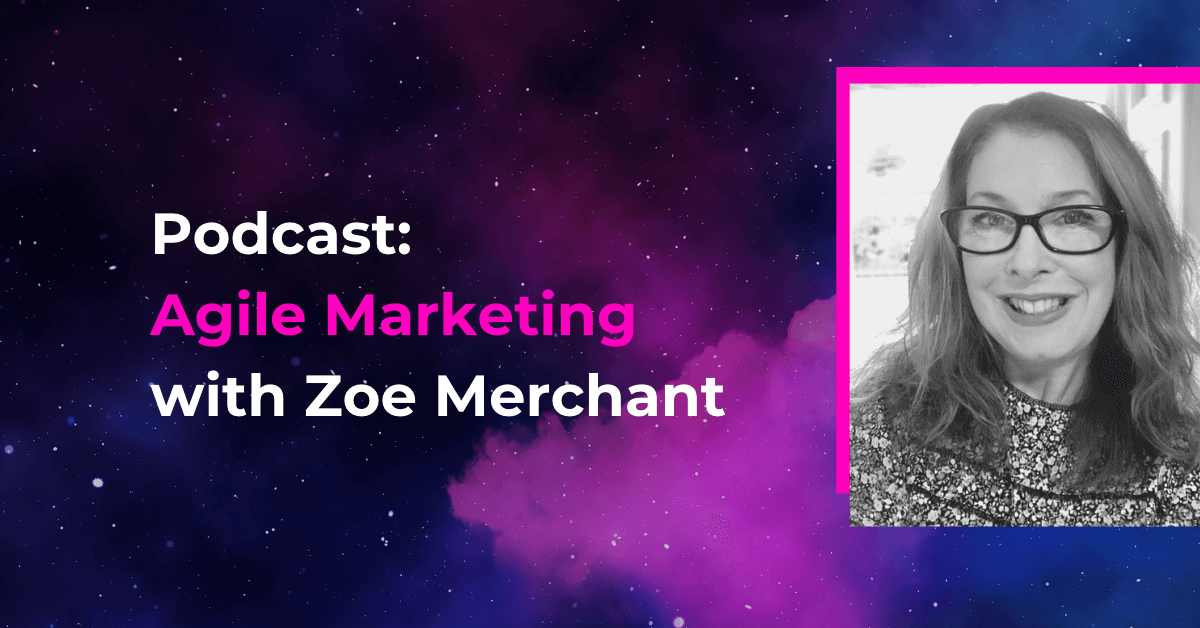

Gain insight into the world of agile marketing, where we use data to test, learn, iterate and refine in an ongoing, process of working towards great marketing success.
Exploring the power of agile marketing in driving FinTech marketing success

If you’ve taken a look at our Traditional vs. Agile marketing infographic, you’re aware of some of the key benefits of agile marketing — but what’s in it for FinTechs and why now, during such a time of disruption?
Even prior to 2020, opening doors in Financial Services was a common barrier to FinTech’s lead generation success. But now, whilst the world is (still) awash with uncertainty and we’re pivoting on the edge of a recession, hammering home the marketing message agreed on in January 2020’s strategy session just isn’t going to support the pipeline. The world has changed, priorities have adjusted, and they will continue to do so as things settle down and the markets stabilise.
With Agile marketing, you can respond and adapt to what’s happening in the industry – staying poised and ready to optimise at a moment’s notice. The message your target audience will receive from a data-driven strategy is one of relevance, support and benefit to the current climate. The groundwork and elements involved in a full agile marketing mix are invaluable to the success of a campaign and the impact on the sales pipeline.
Here’s how to inject agility into your FinTech’s marketing activity to get more leads and boost your performance in the financial services market.
No matter how awesome your tech may be, if your value isn’t clear and focused in addressing the pain points and challenges of your prospects, it’s sure to get lost — leaving your audience feeling unimpressed and disengaged.
To form a powerful value statement, start taking note of the problems you solve and the solutions you deliver for your clients, as well as the benefits your tech and team offer from start to finish. People want to hear about people helping other people — Tell your story and make sure it’s backed up with stats and real-world evidence.
Don’t let data be the bottleneck to reaching your prospects. Define your target audience, create personas, then build and enrich the data to ensure your FinTech’s marketing efforts reach the contacts you want to engage.
Although at times this step can seem like a gruelling manual task, skipping it will only serve to limit your outreach, leaving you missing out on contacting key influencers and decision makers that may need your firm’s offering. Invest in the time and tools necessary to keep your database up to date and give you room to expand on markets where you’re a little thin on the ground.
Yes, content is still king. People don’t buy what you’re selling straight away — they like to browse, research, read a few blogs, or watch a few videos. They want to know that 30-minute call you’re asking for is going to be worth their time, so make it clear what you’re all about. Sharing content that illustrates your employees’ talent, your company’s timely offering and positive testimonials from happy clients can show prospects what they’ve been missing. Their personal data is precious, and they won’t give their email address away for nothing!
Use your data insights and audience personas to brainstorm topics relevant to your prospects’ interests and pain points, then discuss with your subject matter experts from across the business. Each piece of content should have a clear goal in mind.
These three tips are just the tip of the iceberg to transforming your marketing. If you want to dive in deeper and learn how to fully adopt agile marketing at your FinTech, find out more and get in touch. With a decade of experience in the world of FinTech, we understand what it takes to meet your business goals through stand-out marketing campaigns and projects.

We know which side of the ring we want to be – do you?
Want to understand how and where to inject agility and pace into your marketing operation, whilst still driving results and business outcomes? Find out how to get started in our recent blog ‘Getting started with agile marketing‘.

Although many forward-thinking and innovative marketers are already reaping the benefits of the more efficient, agile way of working, with 71% of our survey respondents adopting agile techniques to help them get to market faster – this is a common first reaction when discussing agile marketing transformation. You might understand the concept in the general sense, but few can identify what agile marketing actually is, and perhaps even more importantly, what it isn’t.
Incorporating agility is not about making quick, unfounded decisions as fast as possible to meet a deadline, but about strong, data-driven decision making at pace— reacting to market change and continuously learning for optimised results that provide key takeaways for the next sprint of the project.
There are three core aspects of the agile approach, all of which work together in a successful agile marketing delivery. Check out each component in terms of why it’s important to marketing as a wider function as well as why it is a focus of marketing with agility and pace. If you’d like a more in-depth explanation of what agile is, before deep diving into its components, see our introductory guide.
As the first building block, People is one of the most overlooked and underrated assets of any business. Your team are the driving force that pushes your business forward — an unlimited creative resource and original idea generator that knows no bounds and a big part of the products or services you provide.
When incorporating agility into your marketing strategy, it is people that will deliver to deadlines, meet campaign KPIs and ultimately ensure the success of this project and beyond.
The core principles that drive success in an agile team are ownership and transparency. Individuals take responsibility for what they produce, avoiding siloed work by providing transparency to the rest of the team, or Agile Hub.
Before any project begins, a culture of change and learning with team members is established, creating togetherness, alignment and a positive attitude towards achieving a shared objective. Stakeholder mapping is conducted so as to understand existing processes, dividing roles and responsibilities in a strategic, efficient way. With the internal marketing team’s skills and capabilities reviewed to identify gaps and to help identify how agile marketing experts, such as Bright, can best support throughout the project.
The natural pace of agile marketing makes it an exciting environment for employees who are willing to embrace a move away from a more traditional approach and they are likely to come away with invaluable learnings for future projects. Without realising, you’ve created a more attractive place to work.
The second element of an agile marketing strategy is process. As we work towards the set KPIs, embedding new ways of working and improving performance is key.
Within the sphere of B2B, marketing professionals can be all-too quick to deny the flaws of current processes, instead looking to blame external factors for underperformance. In fact, it’s often only when a project is exposed to a fresh pair of eyes, exploring the unexplored, that holes, flaws and areas for improvement within existing processes come to light.
When adopting an agile approach, you actively seek and identify issues and risks, as well as the dependencies and barriers that can affect the outcome. By being proactive, you not only minimise the likelihood of risks becoming issues, but you also have a better idea about dependencies and can establish effective workarounds as and when required.
By applying the test, learn, iterate model to developing processes, businesses are able to make tweaks and amendments to optimise activity based on data combined with previous experience to establish a closed feedback loop and cultivate continuous improvement. In addition, workplaces encourage a culture of learning within teams, empowering internal teams and providing the know-how to continually achieve fantastic results.
Technology is seamlessly integrated throughout the marketing function, enabling pace, data visibility and informed decision making. This may sound too ideological; tech is often seen as a barrier and too regularly large investments are made only to be side-lined by excel docs, but it’s the third and final building block.
Technology has revolutionised the marketing function to allow for capabilities marketing managers could only dream of a few years ago. According to a report from 2018, there are 2.5 quintillion bytes of data created each and every day, a number that is likely to have accelerated along with the growth of the Internet of Things. 2018, there are 2.5 quintillion bytes of data created each and every day, a number that is likely to have accelerated along with the growth of the Internet of Things.
In order to inform your strategies and create data-driven decisions, it’s essential to put the right tech in place to gain actionable insight. Avoid vanity stats and focus on what can effect change in your results, having a large number of visits to a landing page has little value if they don’t engage with any content on the page or convert.
Adopting agile ways of working removes the perceived barriers outlined above, recognising the role played by technology, championing the use of automation, CRM and project management software. Map your existing martech, identify the gaps and create an adoption plan to ensure your technology is being used effectively to support the wider marketing team. Learn more about how you can optimise your technology with our recent blog post, Making the most of your martech stack.
Could your team benefit from an agile marketing approach? Contact us today to talk further about your current marketing strategy and how the fantastic team here at Bright will be able to help.
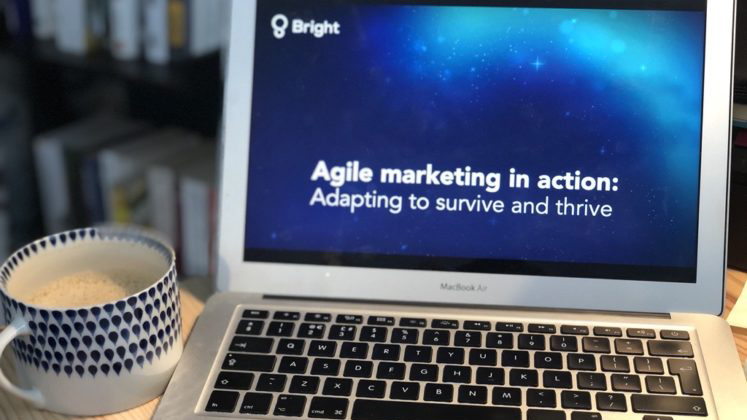
The Bright webinar, Agile marketing in action: Adapting to survive and thrive, went live on Wednesday, 29 April, 11am and safe to say we loved the experience! The virtual event attracted marketing professionals across a diverse range of industries, and it was a brilliant opportunity for us to drive the conversation on all things agile.
The session kicked off, after brief introductions to speakers, by defining the term agile, exploring the success of agility in a broader sense in relation to efficiency, pace, innovation, and reduction of issues and risks. Three core values and principles from the original manifesto were then drawn upon in more detail:
Given the current circumstances affecting businesses across the globe, it was important to mention the COVID-19 outbreak to set context and avoid the overused term ‘unprecedented circumstances’, from dominating the conversation. To do so, we explored why agile marketing is no longer a nicety but now business critical and how this ability to adapt to market disruption is crucial for companies of all shapes and sizes.
We also discussed the challenges our clients and most other marketers are having to deal with at the moment, including frozen budgets, organisational paralysis and poor change management. That said, we are starting to see the most forward-thinking firms focus their attention on lead generation and client retention activities to ensure pipelines don’t fall off a cliff. This means they can build momentum and new business to safeguard their businesses and meet revised sales targets for later this year.
Sian Heaphy, Agile Lead at Bright shared the results of our recent Future of B2B Marketing Report diving into the detail of the survey we undertook and its key findings as well as exploring what these insights actually mean for marketers now. Summing up with the benefits of agile marketing supported by the survey findings and the long-term, tangible benefits we uncovered for teams that adopt an agile way of working.
“It’s given teams greater flexibility, transparency and control over their project tasks. They’re more empowered to collaborate, experiment and react quickly to change when their ideas are validated through the test, learn and iterate approach, critical success factors for resilience.” – Sian Heaphy
Next, Adrian Brooks, Change Lead at British Medical Association (BMA) talked about his experience of introducing agile marketing to take a new proposition to market. This lively discussion detailed the BMA’s journey to inject agility and pace into their marketing practices, barriers to adoption (and how they overcame them) and the results and long-term benefits achieved through the adoption of agile marketing.
The session ended with an interactive Q&A, with Adrian and Sian fielding questions from the audience. There were lots of thought-provoking questions we didn’t have time to cover so we’ve created a complete Q&A below for reference.
The key is to start small. You aren’t going to become an agile marketing team overnight. Find a pilot project (proposition development and / or go to market campaigns work really well for a pilot) where you can test a hypothesis using new ways of working.
Work with an experienced partner (like Bright) and select a handful of your team to work on the pilot and establish an agile marketing hub (3-5 members is a good number) and get them bought into the vision and what you’re trying to achieve. Give them the support and resource they need to run the pilot independently from other activity, taking into account any BAU work they are responsible for.
At BMA we were lucky that at a project level, the leadership team was very supportive. We were working on a new proposition targeting a new market so from the get-go the project ethos was to be different and try new things. There was some resistance within the senior leadership due to the new ways of working suggested so we had to build the business case and confidence for this. Demonstrating why being agile and adaptable would help us get better results and help the in-house team get experience.
BMA had a multi-pronged stakeholder management approach – engaging with the members, steering committee and senior management at a formal level and at a 1:1 level with key people. Regular reporting and transparency on project progress was really critical to generating their buy-in. Agile focus on data and the ability to provide them with insight at every stage to demonstrate the learnings and value we were generating on a week by week basis was invaluable to getting engagement and buy-in.
Tooling is a question we see a lot, and it was one of the biggest barriers to adopting agile marketing identified in our survey.
From a project management perspective, there are a number of ways to get started. Trello is a great tool to get started with to build a simple Kanban board that you can use to create your sprint backlog and monitor progress throughout the sprint.
For a lot of our projects we use Monday.com which offers the same benefits as Trello but is a much more robust project management tool where everyone can easily understand status and priorities. It’s also accessible anywhere by the team which has been important as project team hubs are working remotely.
From a physical perspective at its simplest, creating a workspace in your office where you can create a Kanban board using a white board or post-it notes can be just as effective. In the current climate this isn’t possible, but it can be a great way of bringing the team together in one area to collaborate.
The key to successful sprint management is to make sure that whatever tool or mechanism you’re using to track sprints is being utilised by the team, so you get the visibility you need to understand progress.
Collaboration tools are also key for successful agile hub and management whether you’re using Microsoft Teams, Slack, Skype or any other communication tools, creating a virtual area where team members can interact, collaborate and communicate is critical.
We also use Mural for many virtual creative ideation sessions and to capture retrospectives at the close of each sprint.
The short answer is yes. It’s important to create an overarching goal or KPIs for the project or campaign as a whole and then break it down into specific goals or KPIs for each sprint that will move you towards achieving the project goal.
The great thing about agile ways of working is that it’s data-driven, so you can regularly review your metrics and update and change as you progress. It’s about finding what works and optimising to help you achieve your goal(s).
At BMA, they had a very traditional ways of working with siloed teams, so breaking down that culture was really difficult. It was the biggest challenge/barrier to success. We had really fixed ways of working. One of the ways that we started to break this down was to bring managers into the agile hub so we could talk about the process and resources required in real terms. What was needed at each stage and who would be responsible for it. And giving managers that clarity on how the different elements worked together really helped to break down these ingrained ways of working.
Communication is really important and giving members of the team clear roles and autonomy over their tasks is really powerful, empowering the teams to make their own decisions. With any change you’ll find members of the team who are open to it (and can become great ambassadors for these new ways of working) and others who see it as a threat. Communicate the vision, what you’re trying to achieve and what role they can play in delivering that (and provide the training and support needed to help them) is a great way to start bringing them on that journey.
If you missed our webinar but like the sound of what you’re reading, fear not, as the recording is now available! View the Agile in Action: Adapting to Survive and Thrive webinar today, join our Agile Marketing Club Meet Up group and keep an eye on our social channels for announcements of the next webinar, coming soon to a home-office near you!

The outbreak of Covid-19 has forced the majority of the world to work from home, children to be kept out of school, and trips outside to only be taken once a day for exercise or when collecting and delivering essentials. This is new for all of us and it has unnerved a lot of people into thinking that their marketing actions need to stop until all this is over.
But now more than ever, marketing is critical. It’s the one survival tool at your disposal capable of seeing your business through to the end of this crisis and ensuring success in the years to come. If you’re looking for a simple, cost-effective way to hone your marketing focus, LinkedIn is the place to be. By increasing visibility across the top networking app for business, you’ll keep customers engaged with your brand, stay in touch with partners and suppliers, and build pipeline through steady lead generation. What’s more, the number of users is increasing, with more professionals than ever jumping on to share news, knowledge and business tips for success in times of market disruption.
So, we know LinkedIn is the place to be right now, but you’ll still need a proper strategy to make the most of all this tool has to offer. Now certainly isn’t the time to fire off connection requests and LinkedIn ads without a second thought. There’s a lot to take into consideration when formulating your messaging.
Here’s how to do it:
It’s here, it’s affecting everyone, and it will have an impact on business for years to come. It is already changing the way people live, work and interact. Acknowledge that and acknowledge the hardship in your messaging. Don’t act like it’s just business as usual. This crisis should unite us.
Pitching what was useful back in January when we were all devising our 2020 strategies won’t be of any help or interest right now. Make that mistake and you’ll find yourself reposted with #marketingfail. Take some time to creatively rework your proposition as a benefit in the immediate term and clearly explain how your service will help companies get back on their feet.
If you’re struggling to answer the point above, then you need to go back to the research stage. Don’t stop building pipeline but do reassess your target accounts and verticals quickly. Take the time to fully understand the impact this global crisis will have on your clients’ target markets, then tailor your messaging and service to ensure you’re offering support they need. Retaining existing clients is key to future revenue, so make sure they feel reassured and well managed.
Give your audience the useful tips and how-to guides they need to easily get started with your service or product. Be there as the helpful thought leader of that space when you respond to connections or jump in forum threads, the one they turn to when they need further guidance or support throughout this crisis. And, now that we’re all at home, turn your content into interactive virtual events to inform, engage and inspire your LinkedIn network.
This is an opportunity to build relationships and contact prospects you haven’t been able to reach — consider Account Based Marketing (ABM) to help open up dialogue. With everyone working from home and social distancing, people are now more responsive to an invitation to discuss over a virtual cup of tea (or coffee) and intro video calls. Plus, you’ll have plenty of common ground to discuss and knowledge share in how to combat the impact of COVID-19.
From individual professionals to global enterprises, LinkedIn is the number one social media tool for business right now, and your key to surviving this period of massive market disruption. By researching the impact, pivoting your message accordingly and creating engaging content, your LinkedIn marketing will offer a viable opportunity for interacting with your prospects and supporting them through this time.
At Bright, we’ve been helping our clients quickly pivot their strategies and adapt their messaging on LinkedIn and other social media channels. Watch our immersive webinar as we explore ways to ignite agility, boost leads and perfect communications throughout this challenging time.

“Those who can best manage change will survive.”
Whether you attribute this paraphrased statement to Charles Darwin or someone else, it’s as relevant today as it’s ever been – particularly for Chief Marketing Officers and senior marketers.
To see why, just look around at unparalleled disruption from Brexit, Covid-19 and environmental factors such as climate change, combined with the pace of digital transformation. Technology and data are the catalyst for keeping pace and adapting. For those of us in the business of marketing technology and the products and services that surround it, campaigns have to be just as fast (and agile) to yield sustainable success.
I know it’s easy to say (or write) that CMOs need to leverage agility at pace. But we all know it’s not that easy to incorporate agility and run effective brand building and integrated campaigns. Sometimes it’s down to not having the right tools, not having the time to research what your competitors are up to, or how to change an internal culture used to waterfall ways of working.
Agile is no longer part of start-up thinking — but it’s being adopted by some of the biggest global players
Transforming all this takes time, and that’s a commodity few CMOs have these days. If this all sounds familiar to you, involving external experts (such as Bright), who specialise in agile marketing, can help you work out the best way to approach embedding new ways of working into your team and the wider organisation without impacting the day-to-day marketing tasks you still have to deliver on throughout transformation.
Injecting agile might sound simple, but it involves a change of mindset in your team culture, new processes and sometimes tools or tech. If you don’t have the right skills in your team today, then seeking outside support accelerates that change, minimises risk and avoids the common issues that could undermine the transition. Use a Proof of Concept to research, test and learn what would work best for your organisation and team to start the journey, maintain momentum and embed the right model.
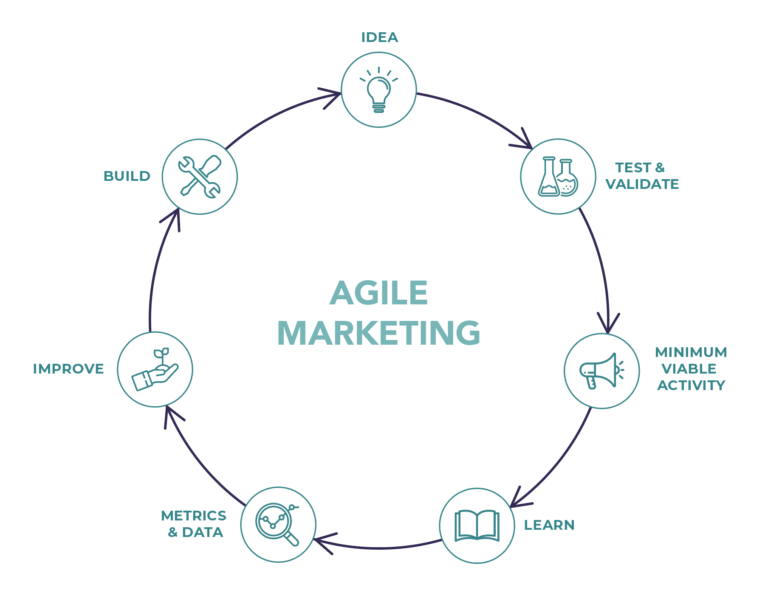
To give you a better idea of this all works, we’ve broken down the true story of how a CMO from a Fintech software and services company championed agile marketing transformation.
Specialising in providing real-time transaction control and enterprise integrity solutions, their sales cycle usually falls somewhere between six and nine months. However, they wanted to accelerate results over a three-month period, and with target accounts in the US and UK, they needed to drive results in both of these territories.
With all this in mind, the CMO wanted to understand if an agile marketing approach was the way to go. Our team needed to prove that it would help the organisation achieve the following:
1. Become more results focused
The agile method of testing, learning and iterating would let the team take more risks, try new approaches and know early-on if their efforts were working.
2. Achieve rapid time to market
‘Sprints’ had helped them get their software to market faster, so they wanted to apply the same approach to their marketing strategies.
[Marketing strategies] need to be scientific. CMOs need to set hypotheses and learn and optimise from every experiment – Zoe Merchant, MD at Bright
3. Become more adaptable
Knowing that software succeeds only when it’s been developed iteratively with a Proof of Concept (PoC), a Minimum Viable Product (MVP) or prototype, they wanted the same iterative approach when going to market to cover the expected, and unexpected, over the three-month campaign.
4. Make data-driven decisions
The marketing team needed a steady source of data to quickly understand their performance and validate and share what they were doing.
On top of these results, the Fintech firm gained a framework that they can use to scale as they grow and build more campaigns. Alongside the results, this is a major value-add from the journey.
The client can now execute ideas, understand their needs, and meet expectations much faster. They get continuous feedback from marketing, sales, and their data, helping them align their teams with results and insight. What’s more, they now feel free to experiment with less risk, and confident that marketing with agility and pace will support their future business goals.

Digital transformation has been in the spotlight for nearly a decade and it remains well entrenched in the average business agenda today. But what about your marketing? How can it adapt to keep up with a changing business whilst meeting market demands?
There’s no doubt that organisation-wide transformation takes time, but marketing often seems to be preoccupied with business as usual or last on the list. Perhaps that’s because there are multiple forces at work in marketing that you’d have to bring into the transformation process. These typically include driving efficiencies, controlling costs, developing insight to drive continual improvement, and making effective use of emerging technology whilst improving your customer experience. And, whilst you make changes to your ways of working, you still need your marketing to demonstrate ROI, realise value in the short term and meet your business goals – smooth marketing transformation is therefore vital to the business as a whole.
It’s a lot to manage, think about and plan for all at once. So, where do you start? It is possible to transform your marketing to drive results that support your business goals, all whilst maintaining activity, but it’s a complex process. Having worked with many companies who are embarking on change, we know how important it is to approach this in a systematic, yet adaptable way – through testing, learning and building on success.
Introducing Agile Marketing Hubs – your personal resource of marketing expertise and innovation. It’s where your in-house team, suppliers and specialists come together to work as one, strong, fully blended team of experts to effectively embed agile ways of working into your culture and operations.
Through hands-on experience in agile delivery of your marketing content, you’ll see greater productivity, energy and collaboration in your marketing team. Agile hubs are the answer to complex marketing transformation and a proven alternative to restrictive traditional techniques or reactive, ad-hoc and unstructured ways of working.
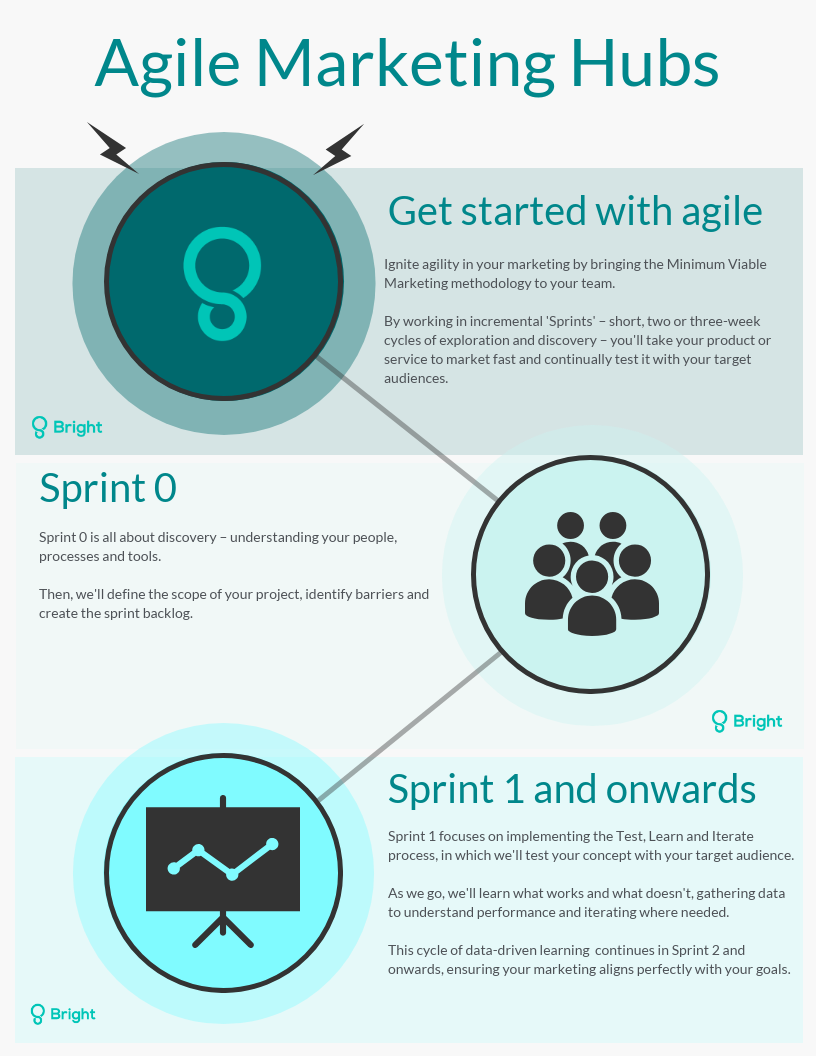
As you continue to work in an agile way, continually learning, building and improving, your team will begin to naturally work together more efficiently and effectively. You’ll also enable more cross-collaboration between different stakeholders and teams in the business – encouraging valuable knowledge-sharing and proving the power of your marketing to drive business goals.
Our tech and consulting clients in high growth and large enterprises have all reported seeing the following benefits from adopting an Agile Marketing Hub:
 Faster time to market Faster time to market |  Data-driven decision making Data-driven decision making |
 Proving marketing ROI at pace Proving marketing ROI at pace |  Productivity and up-skilling Productivity and up-skilling |
 Clear KP and objective setting Clear KP and objective setting |  Scalable agility and innovation Scalable agility and innovation |
In our recent survey, 75% of those who have been practicing agile marketing for more than a year had a better understanding of the power and impact of their marketing. It’s clear that these benefits increase exponentially with prolonged practice of an agile approach.
As your company undergoes digital transformation or needs to rapidly adapt in uncertain times, your marketing needs to keep pace with the market and maintain daily operations. This is a complex challenge that requires time and resources as well as constant support from business leaders and marketing experts. Many struggle to get started and simply lack the tools, support or know-how to embed agile ways of working into their marketing.
With Bright’s Agile Marketing Hubs, you can ignite agility and ensure seamless, integrated and sustainable marketing transformation – with the tools, tactics and concepts you need to drive better results and meet business goals.
Ready to get started? Get in touch to set up an Agile Hub for your marketing today.
Download our report on the Future of B2B marketing to find out the latest insights in B2B marketing and how agile plays a role in transforming the future of marketing.

This is the era of Agile. The ascendancy of experimentation and strategic thinking. The reign of data-driven insights. No matter your industry, everyone seems to be ‘going Agile’. Truth is, following the tech and internet revolution and the rise of Silicon Valley, every industry has had to shift to a more tech and data-driven mindset. And marketers are no different, what with our constant need to be customer centric at the forefront of market change.
But what does it actually mean to be agile in the B2B marketing industry? How do you apply an agile approach to your marketing? Most importantly, why would you leave your proven, traditional marketing techniques behind for new ways of working?
To put it simply, agile marketing is exactly what it sounds like – the application of agile methodology across your marketing. However, that doesn’t give us enough to apply it effectively. In fact, you need to consider your organisational goals and how to drive the change in behaviour that’s needed for embedding a new way of working with your people, process and technology. Agile has a lot of its own lingo, so let’s take a deeper look at the key terms you’ve probably come across, and how they all work together to form an agile marketing approach.
Agile Methodology
In 2001, visionary software developers wrote the Agile Manifesto, highlighting the vital importance of discovery and experimentation in software development. To help others build better, more customer-centric products, they detailed the need for “Individuals and interactions over processes and tools, working software over comprehensive documentation, customer collaboration over contract negotiation and responding to change over following a plan.”
Agile ways of working
Adopting an agile mindset demands redefining your marketing operational model. Where traditional marketing is restrictive, agile emphasises the freedom to be daring in your concept creation and tactics. Rather than spending months planning a solid campaign strategy, an agile marketing team takes a minimum viable approach to take an idea to market as fast as possible in order to test it with the target audience. This of course requires greater collaboration and more effective communication across teams. Don’t worry though, the hard work pays off in the end – with a noticeable boost in efficiency and productivity.
Data vs. insights
We could write an entire book on the importance of being data driven. In short, there’s a clear difference between simply gathering data about your target audience and using that data to your advantage. The most important aspect of an agile marketing approach is to turn your data into actionable insights – really dig deep into who your audience is and what solution they need, to help you build marketing strategies that make an impact.
Sprints
Having adopted agile ways of working, your marketing team will start running campaigns in short bursts – usually within two or three-week intervals called ‘Sprints’. In Sprint 0, you’ll set up data tools to continually gather insights, and create content needed for the campaign. In Sprint 1, you’ll send it all out and test it with a specific section of your audience – say, your followers on LinkedIn. Then, in Sprint 2, you’ll take what you learnt in Sprint 1, iterate, and test again. And so on and so forth.
 The Process
The ProcessTest
So, how do you test, learn and iterate the agile way? By taking your concept to market as fast as possible, you’ll gain valuable time for measuring its effectiveness with your target audience. Did anyone click on your ad? How many responded to your emails? Did you receive any negative feedback about your content or design?
Retrospective
At the end of each sprint, you’ll take a hard look at those actionable insights. Taking note of what worked best with your audience and what failed to impress will help you gain a better understanding of your customers’ needs and what you need to do to reach them in the next Sprint.
Iterate
If you’ve learnt that your concept is working – great! Keep going and expand it to a wider audience. If it isn’t, change it up with a new image, subject line, USP, etc. In this iteration phase, you’ll make all improvements needed to get the results you want in the next Sprint.
This is an infinite cycle of continual testing, learning and improving that you can use throughout your campaigns and projects.
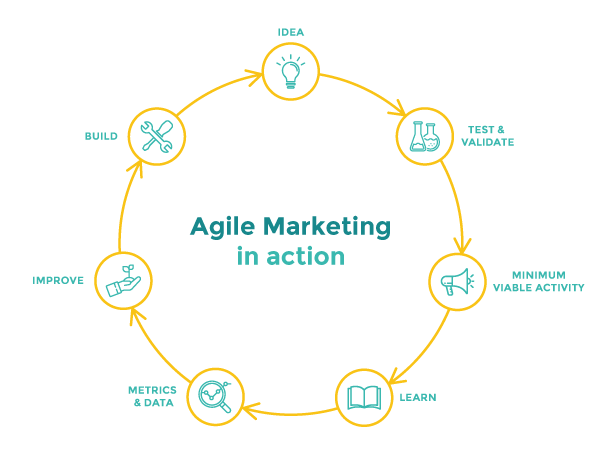
Agility
It’s clear that an agile marketing team is more efficient, effective and empowered. With an agile mindset, your marketing team will work more collaboratively to produce and experiment with new ideas that are more daring and innovative. What’s more, they’ll gain the skills to spring into action when needed, ready to adapt their campaigns and strategies accordingly.
Keeping Pace
Injecting agility into your marketing, is the key to keeping pace – or keeping up- with constant change in the market and the ever-changing demands of your customers. Without a doubt, this is one of the best benefits to adopting an agile marketing approach – the ability to accurately identify and take advantage of opportunities in the market for business growth and brand development.
Fit for purpose
With an agile marketing approach, you’ll see better results and improved performance. What’s more, it’ll become fit for purpose – perfectly aligned with your business goals.
There you have it, a clear breakdown of what it means for B2B marketing to be agile. As our world continues to become more digital and tech-focused, the agile approach will continue to evolve with the market, steadily gaining momentum in its influence. Adopting agile marketing and data-driven ways of working will become essential to success in B2B marketing.
Want to learn more? Check back next week for detailed look on Getting Started with Agile Marketing!

This is the era of agile marketing. The ascendancy of experimentation and strategic thinking. The reign of data-driven insights. But what does that mean for B2B marketing?

If you’re active in B2B marketing, you know that change in the tech and consulting industry is nothing new – and nothing to fear. Within the past decade, we’ve seen digital disruption and transformation drive market change in service and product delivery and impacting how we go to market and reach our target audiences effectively.
In B2B marketing, we’ve dramatically changed how we plan, manage and run campaigns – whether it’s putting data insights to work by injecting agility or using personalisation to keep up with shifting markets. The rise of digitally native audiences has also forced B2B marketing to move much of its activity online.
Now, as we enter a bright new decade, we’re about to see even more changes – our ways of working need to evolve to maintain pace and engagement, and use data and insights effectively to build relationships and convert the right people at the right time. To help you prepare, we’ve gathered the top five trends in B2B marketing this year.
Centred around collective, cross-functional and collaborative working in which projects are completed in short periods called sprints, agile marketing lays the foundation for continually testing and iterating your marketing ideas – proving what works and what doesn’t to ensure better marketing results, business outcomes and overall ROI.
But agile working isn’t just about process and technology – there are cultural considerations to bring your organisation along on the journey. McKinsey research found that companies who adopt agile ways of working simultaneously achieve greater customer centricity, faster time to market, higher revenue growth, lower costs, and a more engaged workforce. Learn more about B2B agile marketing.
Why it will matter in 2020
B2B marketers are under more pressure than ever to demonstrate results from marketing investment, and this is expected to drive a rise in agile marketing adoption in 2020. Firms will need to understand and apply new ways of working to align and meet business goals whilst keeping up with ever-changing markets. Agile marketing brings the best of entrepreneurial thinking, start up ways of working and allows enterprises to innovate at scale.
If you aren’t already, this is your chance to really understand your buyer journey and make sure your marketing is driving revenue at every stage of the client lifecycle. By becoming more agile in your approach, you’ll take advantage of the latest trends and market changes to place your customer at the centre of your business.
Partner experience (PX) has long been a neglected area of marketing. If you want to continue to grow and maximise every revenue opportunity available, then looking at your channel strategy is crucial. The key is to treat your partners as a proper audience – understand their user journey and what they need at every stage.
With an enablement perspective, you can exploit new market opportunities and unlock revenue through your channel. Injecting agility into PX is a great way to start small, such as a partner accelerator or incubator for select partners to supercharge their sales and marketing efforts; or territory specific partner acquisition campaigns to onboard more partners where you need them most. You can test, learn and build on success to create a solid and scalable PX experience.
Why it will matter in 2020
Forester predicts that marketing decision makers will rank improving partner experience on par with improving customer experience in 2020, and both will rise to more than 50%. That’s a significant shift that matches the speed of change we’re seeing in the tech industry. Injecting agility is critical if organisations are going to keep up with competition and build more channel share.
Give your partners the experience they need to support and sell more of your tech and services, and don’t be afraid to stand out and make better use of video, immersive and social prospecting to accelerate traction within and for your channel.
Personalisation has been a marketing buzzword for years and the concept of creating personas to form better buyer journeys shouldn’t be new to you. However, we’re about to see increased personalisation in B2B, specifically with a fresh look at how we’re maintaining continuous communication and opening up meaningful dialogue with our key audiences and clients.
Why it will matter in 2020
Gartner research shows that organisations that have fully invested in all types of personalisation will outsell companies that have not by 20% in 2020. B2B marketers need to step back and think about how they can become more relevant to their key audiences to drive engagement and build relationships for the long term. This must be approached strategically with a willingness to rapidly test and learn in order to be credible and authentic.
Often, marketing can be heavy handed – rushing in with a sales message on a first communication (no one likes a pushy first date!). By using data and insight about the organisational state and target audience, you will be able to craft and deliver relevant, timely and engaging comms. Don’t rush building a credible relationship – be authentic. Senior decision makers have no interest in continuing dialogue with shouty, salesy firms that don’t effectively demonstrate that they have something of value to offer in exchange for their attention.
One way to support your personalisation techniques is with better data insights from predictive analytics. Predictive analytics is the concept of using your data insights to measure marketing activities, identify trends and predict opportunities to create unique, tailored experiences across each stage of your client buyer journey and throughout their client lifecycle.
You probably have data sat within your existing systems and tools that isn’t being effectively used to identify intent and accelerate your buyer journey. Gartner predicts that profitability will replace customer experience as the CMO’s No. 1 strategic priority in 2022. Using data and insight to make strategic decisions and to drive agility and pace in your go to market strategies will be key to understanding marketing performance and contribution to business goals and profitability.
Why it will matter in 2020
Forrester says that 89% of marketers will use more predictive analytics in 2020. To keep up with the competition, the best thing you can do this year is to make your marketing more data driven.
Evaluate how you’re obtaining, measuring and analysing your data and most importantly, if you’re making the most of your data insights. Then, adopt an AI and predictive analytic tool to deliver insight that will support driving marketing effectiveness and align with business goals to demonstrate success at a business contribution level through marketing performance.
Automation tools help marketers schedule and publish content, manage teams and analyse data from multiple sources in one, centralised place. With the proliferation of marketing tools, more streamlined integration will enable better insight and allow marketers to focus on maximising the client experience at every stage of the buyer journey.
Manual tasks are starting to become more easily automated, giving you more time to devote to value-adding activities, such as writing longer-form content and offering greater customisation of your services. Find out more about B2B marketing automation.
Why it will matter in 2020
Evaluating and integrating your existing toolset will create quick wins and allow automation to run sequences autonomously to improve conversion rates and engagement with your key audiences. And, automation isn’t just for external marketing – internal comms will benefit from applying the tools, tactics and automation internally to drive and measure employee engagement.
Marketers need to adopt new ways of working to make the most of your marketing technology. With an agile approach, you’ll zoom in on areas of underperformance to drive improvements, and overperformance to understand and repurpose successful automation into other areas of activity.
2020 will be the year for progressive transformation within B2B marketing. Traditional marketing just won’t make the cut going forward. By understanding how best to adopt agile marketing as a new way of working, streamlining processes and combining the right tools and tech, you’ll be able to adapt and drive change whilst putting your data insights to work to build stronger, clearer marketing strategies for an ever-evolving market.
Want to understand how to get started with agile marketing and transformation? Get in touch with our marketing experts.